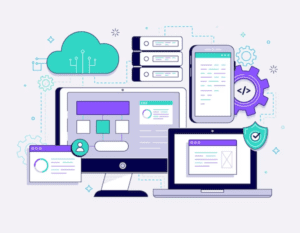DevOps Environment is a culture, set of practices, and tools that enable development and operations teams to work together to deliver software faster and with greater reliability.
Technology is evolving rapidly, and so is the architecture adapted by organizations to handle complex software systems. In the recent decade, organizations have adopted microservices architecture to handle complex software. Microservices architecture works by dividing a monolithic application into small independent parts.
Consider Microservices as lego parts where each part plays its role independently to complete the whole set. This type of structure allows organizations to have flexibility, agility, scalability, and efficiency. Despite so many benefits, there are also some challenges. These challenges include managing and monitoring microservices in the DevOps environment.
In this article, we will explore best practices and tools to manage and monitor microservices in the DevOps environment. This article will provide some useful insight to manage your application. You will find this article useful no matter if you are a newbie or an expert.
Key Challenges in Managing and Monitoring Microservices in a DevOps Environment

Apart from the benefits of incorporating the microservices architecture, there come some challenges. Here are the key challenges in managing and monitoring microservices.
Service discovery and communication
In a system where several microservices are created for different tasks, it can be quite challenging to manage and monitor all the different microservices simultaneously without service discovery and communication.
To understand how big of a challenge it is here is an example. Think of a large library with several books of several different categories. Each shell in the library represents a server with an independent microservice. It would be impossible to find a book if you can not filter books by category and author name.
In the same way, service discovery is important to identify different microservices. Moreover, it is also important to have robust communication between these microservices to improve the system’s overall performance and efficiency.
Monitoring and logging
Another challenge in managing and monitoring microservices is monitoring and logging. Monitoring refers to tracking performance and efficiency while logging refers to gaining insights and solving problems. A microservices architecture consists of several small and big independent microservices which makes the system complex and big for monitoring and logging.
Configuration management
Configuration management is important in managing and monitoring microservices. Synchronization between microservices is important for the overall performance and efficiency of the system. This sync also provides necessary information about the performance of the system as a whole and the performance of individual microservice. For a large system, it can be challenging to manage configuration.
Security and access control
Security is another key challenge in managing and monitoring microservices. So many microservices communicate with each other for efficiency that it becomes hard to authenticate and keep track. Therefore there must be some security measures that authenticate and trace back every communication and protect sensitive data on the server from unauthorized personnel and cyber criminals.
Tools and Technologies for Microservices Management and Monitoring
Here are some of the tools that will help you manage and monitor microservices in a DevOps environment. The choice of tools will depend on factors like the budget of the organization, the needs of the organization, and the complexity of architecture.
Container platforms
Container platforms help package, deploy, and run applications consistently and efficiently. These platforms are important for managing and monitoring microservices in a DevOps environment. These platforms include Docker, Kubernetes, Hat OpenShift, and many more.
All of the container platforms allow developers to package and deploy applications into portable containers.
Service mesh
Service mesh is another critical component for microservices management and monitoring in a DevOps environment. Service mesh tools allow developers to manage service-to-service communication in a microservices infrastructure. Istio is a service mesh tool that provides DevOps teams with features like load management, traffic routing, security and encryption, and configuration management.
Another tool TLS( Transport Layer Security) ensures that access to microservices is only given to authorized people. There are several other service mesh tools available according to the needs and budget of an organization.
Logging and monitoring solutions
Logging and monitoring solutions enable DevOps teams to track and troubleshoot problems within microservices based on the data they have. These tools often increase the performance and efficiency of organizations. One popular logging and monitoring tool is ELK stack (Elasticsearch, Logstash, and Kibana).
Logstash is a data collection pipeline that collects log information. Elasticsearch is a search engine that indexes the log information with different attributes. Lastly, kibana helps developers see the visual interpretation of data to take necessary actions.
There are many other solutions available which include Grafana, Splunk, and Datadog. Each tool offers unique benefits.
API gateways
API gateways are an essential part of microservices. API gateways provide entry points for incoming and outgoing traffic. Kong is a popular API tool used by organizations to manage traffic by rerouting, load balancing, and many others. There are many similar tools available for managing microservices but each has its unique approach.
Best Practices for Managing and Monitoring Microservices in DevOps

Many problems can be faced while managing and monitoring microservices in a DevOps environment. Here are the best practices you need to implement in order to avoid these problems.
Design for failure
One of the most critical aspects of managing and monitoring microservices in a DevOps environment is to avoid failures. This can be done by designing a strong architecture. There should be load balancing, circuit break, and continuous testing and improvements in place to avoid any loss of money, reputation, and data.
Implement automated testing
Automated testing is an important part of the DevOps process, especially when microservices are involved. Automated testing ensures consistent checking of all the microservices. Moreover, all the problems and errors can be identified and fixed early on without any loss. There are different types of automated testing based on organizational needs.
Implement continuous deployment
Another best practice for managing and monitoring microservices in DevOps is implementing continuous deployment. It ensures that their microservices architecture is agile and responsive. New features can be made available for users more consistently.
Monitor metrics and logs
In large organizations to effectively manage and monitor microservices it is important to check metrics and logs. Hundreds and thousands of microservices work simultaneously in a big organization. It is hard to keep track of all of these micro-services. Metrics and logs provide necessary data to identify potential problems and troubleshoot them. It also helps organizations achieve their goal more efficiently.
Implement security controls
Implementing security controls is an essential part of managing and monitoring microservices in a DevOps environment. As all the microservices are connected for continuous and streamlined workflow it is easy to leak data. Therefore it is important to ensure security through encryption, authentication, and access control.
Implement version control
Implementing version control is also a best practice for managing and monitoring microservices in a DevOps environment. It helps identify changes made in the code. It can be done by using tools like git. Moreover, version control also helps roll out new features.
Real-World Examples of Successful Microservices Management and Monitoring in DevOps
Many renowned organizations have successfully monitored and managed microservices in the DevOps environment. You know about these organizations and must be using them at least once a day. Here are some real-world examples of successful microservices management and monitoring in DevOps by organizations.
Netflix
Netflix is a popular streaming service with millions of subscribers. They have hundreds of microservices distributed across regions. Netflix uses different open-source tools for automated integration and deployment. Netflix uses chaos engineering to identify weaknesses in its systems in a closed environment. All of these practices help Netflix become more efficient, cost-effective, and reliable.
SoundCloud
SoundCloud is another successful organization that has managed and monitored microservices in the DevOps environment. Sound cloud uses tools like Docker, Consul, and Prometheus for contamination, monitoring, and configuration management. SoundCloud tests its new features on a small user base and deploy those features based on the reaction from that small group.
Capital One
Capital One is a financial institution that has been successful in managing and monitoring microservices in DevOps. Capital one uses open-source tools like GitHub, jerkins, etc for containerization, deployment, and version control. It also uses CI/CD pipeline to ensure continuous workflow.
Conclusion:
Managing and monitoring microservices in a DevOps environment is essential to ensure the agility, reliability, and scalability of microservices architecture. It is not easy to adopt microservices. To overcome the challenges of this architecture, the right tools are required. Organizations can adopt this architecture by implementing the best practices mentioned in the article. Netflix, Soundcloud, and capitalOne are living examples of effective monitoring and management in DevOps.






